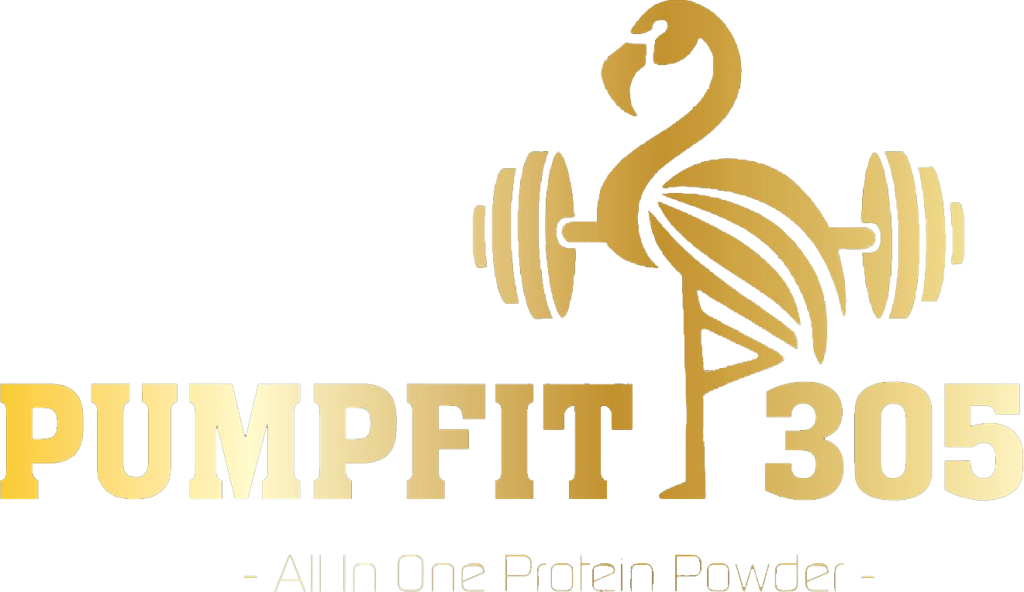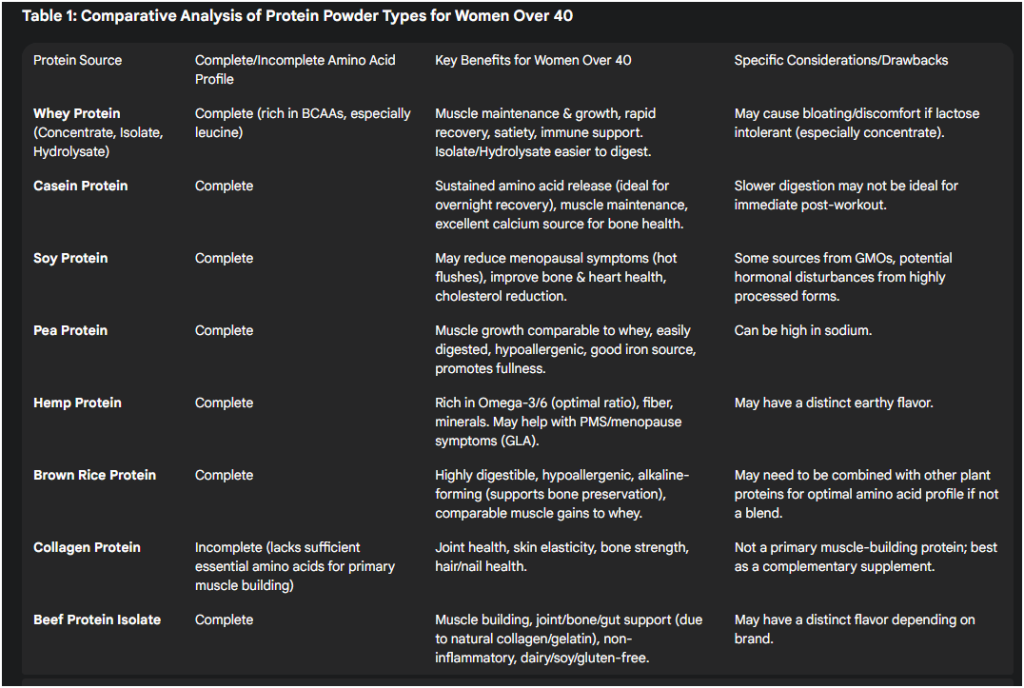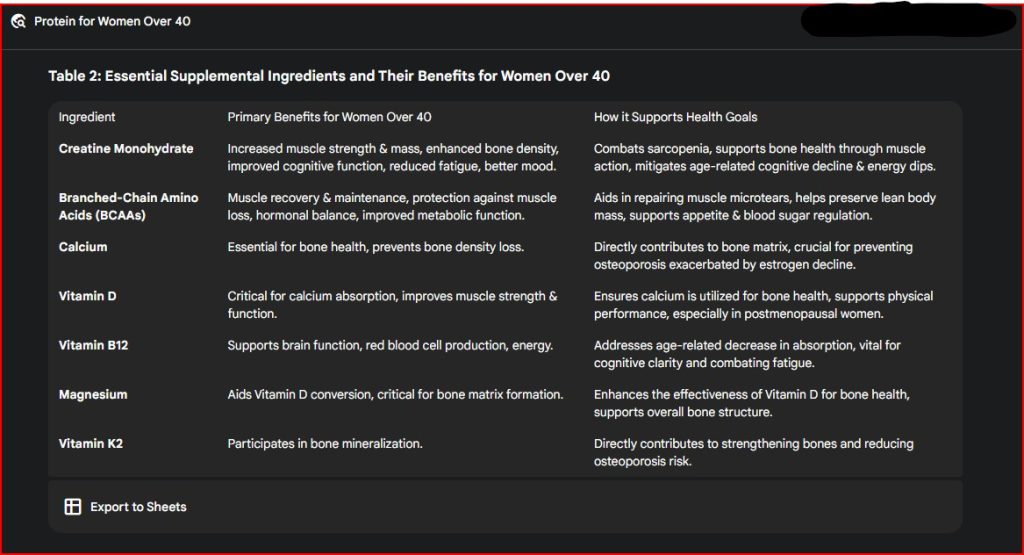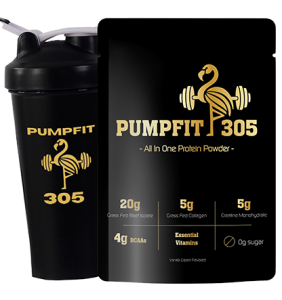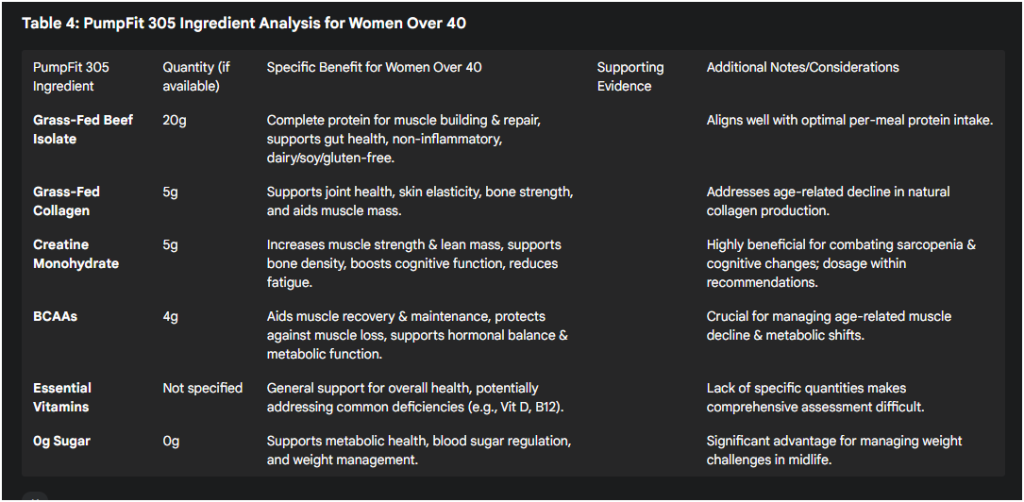Optimizing Health Beyond 40: A Comprehensive Analysis of Protein Powder for Women, with a Focus on PumpFit 305
I. Executive Summary
As women transition through their 40s and beyond, their physiological landscape undergoes significant shifts, necessitating a heightened focus on nutritional intake, particularly protein. This report examines the critical role of protein and other key nutrients in mitigating age-related muscle loss (sarcopenia) and declining bone density, which are prevalent concerns in this demographic. A detailed analysis of various protein powder types and complementary ingredients is provided, followed by a specific evaluation of PumpFit 305’s formulation.
The analysis reveals that PumpFit 305, with its blend of Grass-Fed Beef Isolate, Grass-Fed Collagen, Creatine Monohydrate, and Branched-Chain Amino Acids (BCAAs), inherently aligns remarkably well with the specific, interconnected physiological challenges faced by women over 40. These ingredients collectively support musculoskeletal health, energy levels, and cognitive function. While the product’s marketing does not explicitly target this demographic, its composition offers substantial benefits. However, the absence of clear third-party certifications for purity and safety represents a notable limitation.
Overall, PumpFit 305 can be considered a beneficial supplement for women over 40 seeking comprehensive support for healthy aging, provided that consumers prioritize products with robust third-party verification. General recommendations include integrating protein powders as a supplement to a whole-food diet, emphasizing consistent resistance exercise, and consulting healthcare professionals for personalized nutritional guidance.
II. Introduction: The Evolving Nutritional Needs of Women Over 40
As women enter their 40s, the body embarks on a period of accelerated physiological transformation, largely influenced by fluctuating and eventually declining hormone levels, most notably estrogen. These hormonal shifts profoundly impact fundamental bodily processes, including metabolism, body composition, and the efficiency with which nutrients are utilized. For instance, research indicates that bone mass begins a slow decline after age 40, with calcium intake recommendations increasing significantly as women approach and enter menopause, typically around age 50. Concurrently, the onset of sarcopenia—the age-related loss of muscle mass—becomes more pronounced between the ages of 40 and 50, underscoring a critical need for increased protein intake to counteract this decline.
III. Understanding Physiological Changes in Women Over 40
The period encompassing a woman’s 40s and beyond is characterized by profound physiological transformations, primarily driven by the natural progression towards menopause and its associated hormonal shifts. These changes have significant implications for muscle, bone, and overall metabolic health.
Menopause and Hormonal Shifts
Menopause, typically occurring around age 50, signifies a substantial decline in estrogen production. Estrogen, a hormone with widespread systemic effects, influences far more than just reproductive health. Its decline directly impacts metabolism, often leading to a reduction in resting metabolic rate and alterations in body composition, including an increased propensity for fat distribution around the abdominal area. This hormonal shift also affects nutrient utilization; for instance, the decrease in estrogen can reduce calcium absorption by up to 30%. The presence of phytoestrogens, such as those found in soy, can mimic estrogen’s action, potentially offering benefits like reducing menopausal symptoms (e.g., hot flushes) and improving bone and heart health.
Sarcopenia: Age-Related Muscle Loss
Sarcopenia, defined as the progressive loss of muscle mass, strength, and function, is a natural part of aging that typically begins around age 30 but accelerates significantly after 40-50. Women can experience a loss of 3-5% of muscle mass per decade, potentially accumulating a 20-40% decline by age 70. This reduction in muscle mass directly compromises strength, mobility, physical performance, and overall quality of life. Furthermore, the decrease in metabolically active muscle tissue contributes to a slower resting metabolic rate, making weight management more challenging during this life stage. A key underlying factor in this process is “anabolic resistance,” an age-related phenomenon where the body’s muscle protein synthesis response to dietary protein is blunted, meaning older adults require a higher intake of protein to effectively stimulate muscle growth and maintenance.
Bone Health and Osteoporosis Risk
Concurrent with muscle loss, bone mass also begins to slowly decrease after age 40, significantly increasing the risk of osteoporosis, a condition characterized by weakened and brittle bones. The decline in estrogen during menopause is a primary driver of this accelerated bone loss. To counteract this, adequate daily intake of calcium (1,000-1,200 mg) and vitamin D (600-800 IU) is crucial for preserving bone mass and density. Beyond these minerals, protein plays a vital role in bone health, constituting approximately 50% of bone volume and being essential for bone matrix construction and repair. Alongside nutritional strategies, engaging in weight-bearing exercise, such as running or brisk walking, and resistance training (muscle-strengthening activities) is paramount. These activities place beneficial stress on bones, stimulating bone remodeling and leading to increased bone density.
IV. Optimal Protein Intake for Women Over 40
The dietary protein requirements for women undergo a notable shift as they age, particularly after 40, moving beyond the general recommendations for a sedentary adult.
Revisiting Recommended Dietary Allowances (RDAs) versus Optimal Intake
The standard Recommended Dietary Allowance (RDA) for protein for an average sedentary adult is 0.8 grams per kilogram (g/kg) of body weight per day. For an individual weighing 165 pounds (approximately 75 kg), this translates to a daily intake of 60 grams of protein. However, extensive research now indicates that this conventional RDA is often insufficient for older adults and active individuals, especially women over 40-50, who aim to prevent sarcopenia, maintain functional independence, and preserve their quality of life.
Strategies for Meeting Increased Protein Needs Through Diet
Meeting these increased protein requirements primarily through whole foods is the preferred approach. The healthiest protein options include lean animal sources such as egg whites, fish and seafood, and lean meats like skinless chicken or turkey. Low-fat dairy products are also excellent choices. For those following plant-based diets, good sources include soy, nuts, seeds, beans, and lentils.
The Role of Protein Timing and Distribution
Strategic timing and distribution of protein intake can further optimize its benefits. Spreading protein consumption throughout the day, for example, by consuming boluses of 20-40 grams per meal, has been shown to maximize muscle protein synthesis (MPS), the process by which the body repairs and builds muscle tissue. Beginning the day with a high-protein breakfast is particularly beneficial, as it can help regulate blood sugar levels, enhance satiety, and effectively fuel metabolism for the day ahead. Additionally, consuming protein before meals or immediately following workouts can contribute to overall calorie reduction by increasing fullness and aiding in weight management.
V. Protein Powders: A Strategic Supplement for Midlife Women
Protein powders serve as a highly convenient and concentrated method for women over 40 to meet their elevated protein requirements, especially when dietary intake alone proves insufficient.
General Benefits of Protein Supplementation
Beyond simply adding protein to the diet, these supplements offer a range of benefits pertinent to midlife women. They actively support muscle building and recovery, crucial for combating age-related muscle loss. Protein powders can also aid in weight management by promoting satiety and reducing appetite, thereby contributing to lower overall calorie intake. Furthermore, they play a role in bolstering the immune system and supporting tissue repair, which can be particularly beneficial during periods of recovery from injury or illness. For individuals with busy schedules, protein powders offer a fast and convenient source of essential nutrients.
Types of Protein Powders and Their Suitability for Women Over 40
The choice of protein powder for women over 40 is not merely a matter of protein content but a nuanced decision influenced by individual physiological responses, specific health goals, and dietary preferences. This includes considerations such as digestive sensitivity, lactose intolerance, the desire for enhanced bone density or joint health, and the need for hormonal support. This individualized approach is paramount, as a “one-size-fits-all” recommendation is often ineffective for this demographic.
- Whey Protein: Derived from milk, whey is a complete protein, meaning it contains all nine essential amino acids necessary for muscle repair and preservation. It is particularly rich in branched-chain amino acids (BCAAs), especially leucine, which is critical for stimulating muscle protein synthesis and aiding recovery. Whey protein concentrate is a cost-effective option, while whey protein isolate undergoes further processing to remove most fat and lactose, making it a more suitable choice for individuals with lactose sensitivity. Hydrolyzed whey protein is the purest form and is pre-digested, making it the easiest to absorb. While highly effective for muscle building, weight loss, and immune support, whey protein may cause bloating or discomfort in those sensitive to dairy or lactose.
- Casein Protein: Also derived from milk, casein is a complete protein that distinguishes itself by its slow digestion and absorption rate. This gradual release of amino acids provides a sustained supply to the muscles, making it ideal for maintaining muscle mass, particularly during extended periods of inactivity such as sleep. Casein protein is also an excellent source of calcium, which is highly beneficial for bone health, a critical concern for women over 40.
- Plant-Based Proteins (Soy, Pea, Hemp, Brown Rice): These options are excellent alternatives for individuals who are vegan, have dairy or lactose intolerance, or other allergies.
- Soy Protein: A complete protein source, soy contains phytoestrogens that can mimic the action of estrogen, potentially helping to reduce menopausal symptoms like hot flushes and improving both bone and heart health. It has also been shown to lower cholesterol levels. However, some sources advise caution with highly processed soy supplements for individuals with a high risk of breast cancer, and some soy proteins may be derived from genetically modified sources.
- Pea Protein: This is a high-quality, easily digested protein that is naturally vegan and hypoallergenic. It is a good source of iron, arginine, and BCAAs. Studies indicate that pea protein is as effective as whey for building muscle mass. A consideration is that some pea protein products can be relatively high in sodium.
- Hemp Protein: Considered a complete protein, hemp is rich in omega-3 and omega-6 fatty acids, often in an optimal 3:1 ratio, along with fiber and various minerals. Its gamma-linolenic acid (GLA) content may offer benefits for PMS and menopause symptoms.
- Brown Rice Protein: This protein source boasts high digestibility (over 90%) and a hypoallergenic profile, making it a gentle option for sensitive digestive systems, which is particularly relevant as food sensitivities can increase during menopause. It promotes an alkaline environment in the body, which can help reduce calcium leaching from bones, and provides essential bone minerals like magnesium and phosphorus. Research suggests it can yield comparable results to whey in terms of muscle gains and fat loss.
- Collagen Protein: While a protein source, collagen primarily supports joint health, skin elasticity, and may contribute to strengthening bones and increasing muscle mass. As the body’s natural collagen production declines with age, especially after menopause, supplementation can be beneficial for maintaining connective tissue integrity. It is important to note that collagen may not contain all essential amino acids in sufficient quantities to be a primary muscle-building protein on its own.
- Beef Protein Isolate: This is a complete protein source, often derived from grass-fed beef. It naturally contains collagen and gelatin, offering additional benefits for skin, joint, bone, and gut health. Beef protein isolate is frequently marketed as dairy-free, whey-free, gluten-free, and soy-free, making it a suitable option for individuals with common allergens. Studies suggest it may provide superior benefits to strength, hypertrophy (muscle growth), and fat loss compared to whey, and it is described as non-inflammatory.
VI. Beyond Protein: Key Supplemental Ingredients for Women Over 40
While protein is a cornerstone of nutritional support for women over 40, several other supplemental ingredients offer significant benefits that address the unique physiological changes of this life stage.
Creatine Monohydrate
Historically associated primarily with male athletes and bodybuilders, creatine monohydrate is now increasingly recognized for its substantial benefits for women over 40. This naturally occurring compound, found in small amounts in red meat and seafood and synthesized by the body, is predominantly stored in muscles where it facilitates energy production for quick, powerful movements.
For women over 40, creatine offers multifaceted support:
- Muscle Strength and Lean Mass: Creatine, particularly when combined with resistance training, is highly effective in helping to preserve and build lean muscle mass, improve muscle strength, and enhance functional fitness, directly combating the effects of sarcopenia. It increases the availability of ATP (adenosine triphosphate), the primary energy currency for cellular activities, thereby enabling more intense and effective workouts.
- Support for Bone Health: While not a direct bone-building agent like calcium or vitamin D, creatine plays an indirect yet crucial role in supporting bone health. It strengthens the muscles that exert tension on bones during physical activity, which in turn stimulates bone density. Studies indicate that creatine can enhance the positive effects of resistance training on bone health in postmenopausal women, leading to favorable changes in bone markers. The synergistic effects of creatine and resistance training on both muscle and bone health represent a powerful, often underutilized, strategy for women over 40 to combat the dual challenges of sarcopenia and osteoporosis. This approach moves beyond viewing supplements as isolated fixes, highlighting the importance of integrating supplementation with lifestyle interventions, such as exercise, to achieve superior outcomes for complex, interconnected age-related conditions.
- Cognitive Benefits: Creatine also extends its benefits to cognitive function. It supports brain power by enhancing mental clarity, working memory, focus, and decision-making, and can effectively reduce mental fatigue. These cognitive advantages are particularly relevant given the common experience of “brain fog” and memory lapses during perimenopause and menopause.
- Fight Fatigue and Improve Mood: By influencing brain energy metabolism, creatine may help combat low energy levels and general fatigue, while also contributing to improved mood and emotional resilience during hormonal transitions.
- Dosage: A typical daily dosage of 3-5 grams of creatine monohydrate is recommended for women over 40.
Branched-Chain Amino Acids (BCAAs)
BCAAs, comprising leucine, isoleucine, and valine, are essential amino acids that the human body cannot synthesize and must therefore be obtained through diet or supplementation. They are fundamental building blocks that play critical roles in various biological processes.
- Role in Muscle Recovery and Maintenance: BCAAs are crucial for stimulating muscle protein synthesis, aiding in the recovery process after high-intensity exercise by repairing muscle microtears, alleviating soreness, and protecting against age-related muscle loss. This is particularly important as women begin to experience a decline in lean body mass after age 40.
- Hormonal Balance: BCAAs can contribute to hormonal balance by regulating key hormones such as leptin, adiponectin, and glucagon. These hormones are integral in moderating appetite, converting fat cells into energy, and maintaining stable blood sugar levels. Additionally, BCAAs can stimulate the release of hormones vital for a healthy immune response and mental well-being.
- Metabolic Function: BCAAs can enhance the body’s efficiency in metabolizing fat and glucose, thereby promoting lean muscle mass and potentially reducing fat storage. This metabolic support is especially beneficial for women, who generally tend to have slower metabolisms compared to men.
It is important to understand that BCAAs are components of complete protein and are not a substitute for comprehensive protein intake.
Essential Vitamins and Minerals
Beyond protein and amino acids, several vitamins and minerals are critically important for supporting the health of women over 40:
- Calcium: This mineral is paramount for maintaining bone health. Women over 40 should aim for a daily intake of 1,000-1,200 mg. Dietary sources include dairy products, leafy greens, fortified foods, and fish with bones.
- Vitamin D: Essential for the absorption of calcium in the intestine, Vitamin D is crucial for bone health. The recommended intake is 600-800 IU per day, with needs potentially increasing with age. While sunlight aids natural production, supplementation is often necessary. Vitamin D3, specifically, has been shown to improve muscle strength and function, particularly in postmenopausal women with insufficient levels.
- Vitamin B12: As individuals age, the body’s ability to absorb Vitamin B12 can decrease. This vitamin is vital for brain function and the production of red blood cells. Good dietary sources include lean meat, fish, milk, eggs, and fortified cereals.
- Magnesium: This mineral plays a crucial role in converting vitamin D to its active form and is a critical co-factor in the formation of the bone matrix.
- Vitamin K2: This vitamin participates directly in bone mineralization, contributing to overall bone strength and integrity.
VII. Ensuring Safety and Quality in Protein Supplements
The dietary supplement market operates under a different regulatory framework than pharmaceutical drugs, with the Food and Drug Administration (FDA) not approving dietary supplements for safety or efficacy prior to their market release. This regulatory approach places the onus on individual companies to ensure their products, facilities, and production methods meet safety standards. This lack of pre-market approval inherently increases the risk of product contamination, mislabeling, or the inclusion of lower-quality ingredients. Consequently, consumers must exercise heightened scrutiny when selecting protein supplements.
Ingredients to Scrutinize or Avoid
To ensure safety and avoid potential adverse effects, consumers should be vigilant about certain ingredients commonly found in protein powders:
- Heavy Metals: Concerns have been raised regarding the presence of contaminants such as arsenic, cadmium, mercury, and lead in protein powders. Plant-based protein powders, in particular, may contain higher levels of these metals due to the plants’ absorption from the soil, and chocolate-flavored powders have also shown elevated levels. While trace amounts may not pose an immediate health risk, minimizing overall exposure to heavy metals is a prudent health strategy.
- Artificial Sweeteners: Common artificial sweeteners like Sucralose (Splenda), Aspartame (NutraSweet, Equal), and Saccharin can trigger negative reactions in some individuals, including headaches, migraines, gastrointestinal distress, depression, and even contribute to weight gain.Fillers and Gums: Ingredients such as dextrins/maltodextrin (often derived from genetically modified corn), skim milk powders/milk solids (which are high in lactose), and various gums like xanthan gum are frequently used as cheap bulking agents or to improve mixability. However, these can lead to significant gastrointestinal discomfort, including bloating, gas, and constipation.
- Processed Soy Protein: Some soy proteins may originate from genetically modified sources associated with high pesticide use. Furthermore, certain chemical compounds within soy protein have been linked to potential hormonal disturbances in sensitive individuals.
- Hydrogenated Vegetable Oils and Fats: These ingredients are sometimes added to enhance richness or creaminess in protein powders, particularly those marketed for weight loss. However, they often contain trans fats, which are known to elevate “bad” cholesterol (LDL) and lower “good” cholesterol (HDL), posing a significant risk to cardiovascular health.
- Casein + WPC (Whey Protein Concentrate): These forms of dairy protein are high in lactose and can be more challenging for some individuals to digest, potentially leading to bloating and other gastrointestinal issues.
The Importance of Third-Party Certifications
In a largely unregulated supplement market where the FDA does not pre-approve products, third-party certifications become the primary mechanism for consumers to verify product safety, purity, and label accuracy. This effectively shifts the burden of quality assurance from the individual consumer to independent expert bodies. These certifications are considered the “gold standard” for ensuring the quality and purity of protein powders. Independent organizations conduct rigorous inspections of manufacturing facilities, verify adherence to Good Manufacturing Practices (GMP), and perform comprehensive testing of products for banned substances, contaminants, and the accuracy of label claims.
- NSF Certified for Sport: This robust certification program screens for over 270 banned substances, conducts unannounced GMP facility audits, performs product toxicology assessments, tests raw product materials, and verifies the accuracy of the Supplement Facts label. Critically, every batch of a product is tested before it is released to the market. This certification is recognized by major athletic organizations, underscoring its stringent standards.
- Informed Sport / Informed Choice: These certifications screen for over 200 banned substances, conduct random GMP facility audits, perform product toxicology assessments, and test raw product materials. Informed Sport tests every batch, while Informed Choice involves monthly blind testing of products purchased from retail.
- Good Manufacturing Practice (GMP): While not a certification for the product itself, GMP certification indicates that the manufacturing facility adheres to guidelines ensuring cleanliness, sanitation, and proper manufacturing and storage practices.
- Clean Label Project: This non-profit organization analyzes products for heavy metals, pesticides, and contaminants like BPA. While their reports are not always peer-reviewed, they highlight potential concerns and encourage greater transparency.
These certifications transform the purchasing decision from a leap of faith into an informed choice based on external validation. They empower consumers by providing a trusted proxy for safety and quality in an otherwise opaque market, making them essential criteria for selecting any protein powder, particularly for women over 40 who may have specific health concerns or sensitivities.
VIII. In-Depth Analysis: PumpFit 305 for Women Over 40
PumpFit 305 positions itself as an “all-in-one solution for your fitness goals,” aiming to redefine the supplement industry by providing “clean, effective nutrition”. The product is marketed as being crafted with “premium ingredients,” “high-quality protein,” and “essential vitamins, minerals, and superfoods”. It is important to note that the PumpFit 305 website does not contain specific content or recommendations tailored for women over 40 regarding their protein powder or general fitness/nutrition. The marketing is general, focusing on “dynamic people” and “optimal performance”.
Ingredient Breakdown and Evaluation for Women Over 40
Despite PumpFit 305’s general marketing, its specific ingredient profile inherently aligns remarkably well with the specific, interconnected physiological challenges faced by women over 40, making it a highly relevant product for this demographic, even if not explicitly positioned as such by the brand. The combination of beef isolate, collagen, creatine, and BCAAs creates a powerful, multi-pronged approach to supporting musculoskeletal health, energy, and cognitive function in aging women.
- 20g Grass-Fed Beef Isolate:
- Specific Benefit for Women Over 40: Beef protein isolate is a complete protein, providing all essential amino acids crucial for muscle building and repair. It naturally contains collagen and gelatin, which offer additional benefits for skin, joint, bone, and gut health. This protein source is often preferred by individuals avoiding dairy, soy, or gluten, and is described as non-inflammatory, which is beneficial for managing digestive sensitivities that can increase in midlife. Studies suggest that beef protein may offer advantages over whey for strength, hypertrophy (muscle growth), and fat loss. The 20g per serving aligns effectively with the recommended per-meal protein boluses for optimal muscle protein synthesis in older adults.
- 5g Grass-Fed Collagen:
- Specific Benefit for Women Over 40: Collagen is a critical structural protein in the body, essential for joint health, skin elasticity, and the integrity of bones. As natural collagen production declines with age, particularly after menopause, supplementation becomes highly beneficial for addressing common concerns such as joint pain, skin aging, and the reduction in bone density exacerbated by estrogen loss. Its inclusion alongside beef isolate provides a dual approach to supporting musculoskeletal and connective tissue health.
- 5g Creatine Monohydrate:
- Specific Benefit for Women Over 40: Creatine is a standout ingredient for this demographic due to its profound benefits. It is highly effective for increasing muscle strength, preserving lean muscle mass, and enhancing functional fitness, especially when combined with resistance training. It directly counteracts sarcopenia, a major concern for women over 40. Furthermore, creatine supports bone health by strengthening the muscles that exert beneficial forces on bones, which is crucial for bone density, a significant concern post-menopause. Beyond physical benefits, creatine can boost cognitive function, reduce mental fatigue, and potentially improve mood, addressing common cognitive and energy-related symptoms experienced in midlife. The 5g dosage is well within the recommended daily intake for women over 40.
- 4g BCAAs:
- Specific Benefit for Women Over 40: Branched-Chain Amino Acids (leucine, isoleucine, valine) are essential for stimulating muscle protein synthesis, aiding in muscle recovery, and protecting against age-related muscle loss. This is particularly crucial as women age and naturally experience a decline in muscle tissue. Additionally, BCAAs contribute to hormonal balance and metabolic function, assisting with the efficient metabolism of fat and glucose, which aligns with the needs of women navigating midlife changes.
- Essential Vitamins:
- Specific Benefit for Women Over 40: The product states it contains “Essential Vitamins”. While specific vitamins and their quantities are not detailed, a comprehensive blend would ideally include those critical for women over 40, such as Vitamin D, Vitamin B12, and potentially Vitamin K2. These micronutrients are vital for bone health, energy production, and cognitive function, addressing common deficiencies or increased needs in this age group.
- 0g Sugar:
- Specific Benefit for Women Over 40: The absence of added sugars is highly beneficial for metabolic health, blood sugar regulation, and weight management. This is particularly advantageous for women over 40, as their resting metabolic rate often drops during menopause, making weight management more challenging. Minimizing sugar intake supports healthy body composition and reduces the risk of chronic diseases.
Assessment of “All-in-One Solution” Claim
PumpFit 305’s combination of beef isolate, collagen, creatine, and BCAAs makes it a highly comprehensive “all-in-one” solution for musculoskeletal health, recovery, and performance. It effectively bundles several key supplements that would typically be purchased separately, offering convenience and a synergistic approach to these specific health areas.
Considerations and Gaps
- Lack of Specific Targeting: A significant gap is the absence of specific marketing or educational content on the PumpFit 305 website tailored to women over 40. While the product’s ingredients are highly relevant to this demographic, the company does not explicitly educate these consumers on
why their product is uniquely suited for their physiological needs. This represents an under-marketing of its inherent value to a specific, high-need population.
- Third-Party Certifications: The provided information does not indicate whether PumpFit 305 undergoes third-party testing (e.g., NSF Certified for Sport, Informed Sport/Choice). This is a critical safety and quality consideration in the supplement industry, especially given concerns about heavy metals and other contaminants in protein powders. Without such certifications, consumers lack independent verification of purity, potency, and label accuracy.
- Specific Vitamin/Mineral Profile: The general mention of “essential vitamins” without a detailed breakdown of specific types and quantities (e.g., Calcium, Vitamin D, B12) makes it challenging to ascertain if the product adequately addresses the specific micronutrient needs and potential deficiencies common in women over 40.
IX. Conclusion and Recommendations
Summary of PumpFit 305’s Strengths and Limitations for Women Over 40
PumpFit 305 presents a compelling formulation for women over 40, offering a highly relevant and synergistic blend of ingredients. Its inclusion of Grass-Fed Beef Isolate provides a complete, digestible, and non-inflammatory protein source, crucial for combating sarcopenia and supporting overall muscle health. The addition of Grass-Fed Collagen directly addresses common concerns such as joint pain, skin elasticity, and bone density, which are exacerbated by age and hormonal changes. Furthermore, the presence of Creatine Monohydrate is a significant advantage, offering robust support for muscle strength, bone health, cognitive function, and energy levels—all critical areas for women in midlife. The inclusion of BCAAs further enhances muscle recovery and metabolic support. The product’s commitment to 0g sugar is also highly beneficial for metabolic health and weight management.
However, PumpFit 305 does exhibit limitations. The most notable is the absence of specific marketing and educational content tailored to women over 40 on its website, which means the brand is under-positioning its inherent value to this demographic. More critically, the provided information does not indicate whether the product undergoes independent third-party certifications for purity and safety (e.g., NSF Certified for Sport, Informed Sport/Choice). In a supplement market where regulatory oversight is not pre-market, such certifications are paramount for consumer trust and assurance against contaminants. Additionally, while “essential vitamins” are mentioned, the lack of a detailed breakdown of specific micronutrients and their quantities makes it difficult to assess if the product fully addresses all increased vitamin and mineral needs of women over 40.
General Recommendations for Women Over 40 Considering Protein Supplements
For women over 40 considering protein supplementation, a strategic and informed approach is recommended:
- Prioritizing Whole Food Protein Sources: Protein powders should always serve as a supplement to, rather than a replacement for, a balanced diet rich in whole food protein sources. A diverse intake of lean meats, fish, eggs, dairy, and plant-based proteins remains foundational for comprehensive nutrition.
- Effective Use of Protein Powders: Protein powders can be strategically incorporated into the daily routine to help meet elevated protein targets and optimize muscle protein synthesis. They are particularly beneficial as part of a high-protein breakfast, immediately post-workout, or as a convenient, satiating snack to prevent energy crashes and manage cravings.
- Importance of Consulting Healthcare Professionals: It is always advisable to consult with a physician or a registered dietitian to determine personalized protein needs and assess the suitability of any supplement. This is especially crucial for individuals with underlying health conditions, such as kidney disease, or those on specific medications.
- Emphasis on a Holistic Approach: Optimal health beyond 40 necessitates a multi-faceted strategy that extends beyond protein supplementation alone. This comprehensive approach includes consistent engagement in both weight-bearing and resistance exercise to support muscle and bone health, ensuring adequate hydration, implementing effective stress management techniques, and prioritizing quality sleep. Protein powder, while valuable, functions as a tool within this broader framework of holistic wellness.
